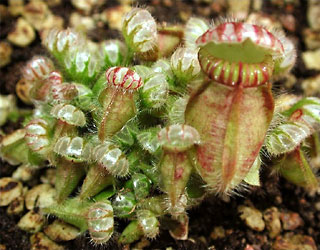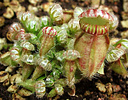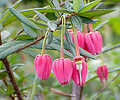Oxalidales



This tree diagram shows the relationships between several groups of organisms.
The root of the current tree connects the organisms featured in this tree to their containing group and the rest of the Tree of Life. The basal branching point in the tree represents the ancestor of the other groups in the tree. This ancestor diversified over time into several descendent subgroups, which are represented as internal nodes and terminal taxa to the right.

You can click on the root to travel down the Tree of Life all the way to the root of all Life, and you can click on the names of descendent subgroups to travel up the Tree of Life all the way to individual species.
For more information on ToL tree formatting, please see Interpreting the Tree or Classification. To learn more about phylogenetic trees, please visit our Phylogenetic Biology pages.
close boxReferences
Barnes, R. W., R. S. Hill, and J. C. Bradford. 2001. The history of Cunoniaceae in Australia based on macrofossil evidence. Australian Journal of Botany 49:301-320.
Bradford, J. C. and R. W. Barnes. 2001. Phylogenetics and classification of Cunoniaceae (Oxalidales) using chloroplast DNA sequences and morphology. Systematic Botany 26:354-385.
Hufford, L. and W. C. Dickison. 1992. A phylogenetic analysis of Cunoniaceae. S ystematic Botany 17:181-200.
Matthews, M. L. and P. K. Endress. 2002. Comparative floral structure and systematics in Oxalidales (Oxalidaceae, Connaraceae, Brunelliaceae, Cephalotaceae, Cunoniaceae, Elaeocarpaceae, Tremandraceae). Botanical Journal of the Linnean Society 140:321-381.
Matthews, M. L., P. K. Endress, J. Schönenberger, and E. M. Friis. 2001. A comparison of floral structures of Anisophylleaceae and Cunoniaceae and the problem of their systematic relationship. Annals of Botany 88:439-455.
Orozco, C. I. and F. Weberling. 1999. A comparative study of inflorescences in Brunellia Ruiz & Pav. (Brunelliaceae) and related taxa. Beiträge zur Biologie der Pflanzen 71:261-279.
Qiu, Y. L., J. H. Lee, F. Bernasconi-Quadroni, D. E. Soltis, P. S. Soltis, M. Zanis, E. A. Zimmer, Z. D. Chen, V. Savolainen, and M. W. Chase. 2000. Phylogeny of basal angiosperms: Analyses of five genes from three genomes. International Journal of Plant Sciences 161:S3-S27.
Savolainen, V., M. W. Chase, S. B. Hoot, C. M. Morton, D. E. Soltis, C. Bayer, M. F. Fay, A. Y. De Bruijn, S. Sullivan, and Y. L. Qiu. 2000a. Phylogenetics of flowering plants based on combined analysis of plastid atpB and rbcL gene sequences. Systematic Biology 49:306-362.
Savolainen, V., M. F. Fay, D. C. Albach, A. Backlund, M. van der Bank, K. M. Cameron, S. A. Johnson, M. D. Lledó, J.-C. Pintaud, M. Powell, M. C. Sheahan, D. E. Soltis, P. S. Soltis, P. Weston, W. M. Whitten, K. J. Wurdack, and M. W. Chase. 2000b. Phylogeny of the eudicots: a nearly complete familial analysis based on rbcl gene sequences. Kew Bulletin 55:257-309.
Schönenberger, J., E. M. Friis, M. L. Matthews, and P. K. Endress. 2001. Cunoniaceae in the Cretaceous of Europe: evidence from fossil flowers. Annals of Botany 88:423-437.
Soltis, D. E., P. S. Soltis, M. W. Chase, M. E. Mort, D. C. Albach, M. Zanis, V. Savolainen, W. H. Hahn, S. B. Hoot, M. F. Fay, M. Axtell, S. M. Swensen, L. M. Prince, W. J. Kress, K. C. Nixon, and J. S. Farris. 2000. Angiosperm phylogeny inferred from 18S rDNA, rbcL, and atpB sequences. Botanical Journal of the Linnean Society 133:381-461.
Information on the Internet
Albany pitcher plant, Cephalotus follicularisTitle Illustrations

| Scientific Name | Cephalotus follicularis |
|---|---|
| Location | Native to Southwest Australia |
| Comments | Albany pitcher plant. Specimen cultivated at the Botanical Garden Basel, Switzerland. |
| Acknowledgements | courtesy Botanical Image Database |
| Copyright |
© 2001 University of Basel, Basel, Switzerland

|
| Scientific Name | Crinodendron hookeranum |
|---|---|
| Comments | Flower of the lantern tree (Elaeocarpaceae) |
| Copyright |
© Kurt Stüber

|
About This Page
Page copyright © 2009
All Rights Reserved.
Citing this page:
Tree of Life Web Project. 2002. Oxalidales. Version 01 January 2002 (temporary). http://tolweb.org/Oxalidales/21032/2002.01.01 in The Tree of Life Web Project, http://tolweb.org/









 Go to quick links
Go to quick search
Go to navigation for this section of the ToL site
Go to detailed links for the ToL site
Go to quick links
Go to quick search
Go to navigation for this section of the ToL site
Go to detailed links for the ToL site